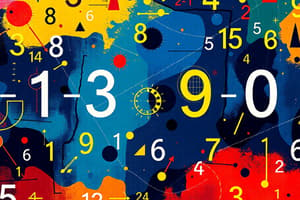Podcast
Questions and Answers
What is the primary purpose of simplifying algebraic expressions?
What is the primary purpose of simplifying algebraic expressions?
- To eliminate all variables from the expression
- To make them compatible with ratios and proportions
- To apply basic arithmetic and combine like terms (correct)
- To convert them into numerical values only
Which method is useful for solving linear equations effectively?
Which method is useful for solving linear equations effectively?
- Isolating the unknown variable to determine its value (correct)
- Applying random substitutions without systematic steps
- Using division for both sides without regard for signs
- Balancing variables with fractions without common denominators
What is a key characteristic of ratios?
What is a key characteristic of ratios?
- They compare two quantities of different types only
- They always represent whole numbers
- They can be written as fractions or simplified to lowest terms (correct)
- They must always be expressed in decimal form
How do you accurately calculate the average rate of change between two quantities?
How do you accurately calculate the average rate of change between two quantities?
What aspect of geometric shapes is crucial for understanding their properties?
What aspect of geometric shapes is crucial for understanding their properties?
Which method is most appropriate for discovering the correlation between two variables in a data set?
Which method is most appropriate for discovering the correlation between two variables in a data set?
When calculating the area of a triangle, which formula is used?
When calculating the area of a triangle, which formula is used?
Which transformation does not change the size of a shape?
Which transformation does not change the size of a shape?
In which scenario is the range useful for interpreting a data set?
In which scenario is the range useful for interpreting a data set?
When determining the angle relationships in a triangle, which statement is true?
When determining the angle relationships in a triangle, which statement is true?
Flashcards
Perimeter
Perimeter
The total length of all the sides of a shape added together.
Area
Area
The amount of space a two-dimensional shape covers.
Volume
Volume
The amount of space a three-dimensional object occupies, measured in cubic units.
Reflection
Reflection
Signup and view all the flashcards
Rotation
Rotation
Signup and view all the flashcards
Place Value
Place Value
Signup and view all the flashcards
Rounding Numbers
Rounding Numbers
Signup and view all the flashcards
Algebraic Expression
Algebraic Expression
Signup and view all the flashcards
Proportion
Proportion
Signup and view all the flashcards
Study Notes
Number
- Understanding place value is crucial for working with large and small numbers. This involves recognizing the value of each digit based on its position in the number.
- Rounding numbers to a given degree of accuracy is a fundamental skill. This involves approximating a number to a specified level of precision. Common rounding rules apply (e.g., 5 or above, round up).
- Ordering and comparing numbers involves placing numbers in ascending or descending order based on their value.
- Basic arithmetic operations (addition, subtraction, multiplication, and division) form the foundation of many mathematical concepts. Proficiency in these is essential. Different methods (columnar, grid, etc.) can be used.
- Calculating with positive and negative numbers follows specific rules for each operation. Understanding these rules is key to accuracy.
- Understanding factors, multiples, prime numbers, and prime factorization is vital for solving problems involving divisibility and factorization.
Algebra
- Variables used in algebraic equations represent unknowns. These allow for generalised statements and solutions.
- Simplifying expressions involves applying rules of arithmetic and combining like terms.
- Working with equations and inequalities involves using correct methods such as balancing equations and knowing when signs change.
- Solving linear equations needs isolating the unknown to find its value.
- Forming and solving simple linear equations is a core skill.
- Substituting values into expressions requires replacing variables with their corresponding values and simplifying the result.
- Understanding and using function notation (e.g., f(x)) is crucial for expressing functions and calculating output values for given inputs.
Ratio, Proportion, and Rates of Change
- Ratio compares two quantities of the same type. These are often in simplified form or written as fractions.
- Proportion relates two or more quantities proportionally, with a consistent relationship between them.
- Rates of change describe how one quantity changes relative to another. This can be found using gradients or using a change in one variable over a change in another.
- Applying ratio and proportion involves setting up and solving problems involving sharing quantities, scaling diagrams, and similar shapes.
Geometry and Measure
- Understanding geometric shapes (e.g., triangles, quadrilaterals, circles) and their properties is essential. This includes angles, lengths, and areas.
- Calculating perimeters, areas, and volumes of various shapes, using appropriate formulas and units, is crucial.
- Working with angles of shapes (angles on a straight line, angles around a point, vertically opposite angles) plays an important role in many geometric problems.
- Constructing geometric shapes using a variety of tools (ruler, compass, protractor) and techniques is often required.
- Transformations (reflection, rotation, translation, enlargement) involve changing positions of shapes. Knowing the relevant transformations is vital.
- Understanding congruence and similarity in shapes is important for comparing and working with geometric figures.
- Understanding coordinates and plotting graphs in different quadrants is essential in coordinate geometry.
Statistics
- Collecting, interpreting, and presenting data using various methods (tables, charts, graphs) is vital.
- Calculating different types of averages (mean, median, mode) and measures of spread (range, interquartile range) requires understanding the relevant formulae and techniques.
- Analysing data from charts and graphs to extract information, interpreting trends, and making predictions based on observed patterns.
- Understanding measures of central tendency and spread helps describe and compare data sets effectively.
- Creating and interpreting scatter graphs to identify any correlations or relationships between two sets of data is important.
- Drawing conclusions from data in an informed and logical manner is critical.
Probability
- Calculating probability involves using appropriate techniques like fractions, ratios, or percentages of likelihood, to find the desired outcome from all potential outcomes of an event.
- Understanding probability requires analysing possible outcomes by considering all possibilities.
- Exploring different probability models (e.g., two-way tables) and associated techniques. This allows for calculating probabilities for various cases.
Other Important Topics
- Problem-solving strategies and their application to mathematical problems.
- Using mathematical instruments correctly, for example, a protractor and compass.
- Accurate representation of diagrams and shapes.
- Carefully choosing suitable units of measurement and conversions.
- Understanding and accurately representing different mathematical notations.
- Using different methods to solve a single problem, comparing and contrasting them to find the most efficient route to a solution.
- Communicating mathematical ideas clearly and concisely, using appropriate language and symbols.
- Mathematical reasoning and deduction is fundamental throughout the course.
Studying That Suits You
Use AI to generate personalized quizzes and flashcards to suit your learning preferences.




